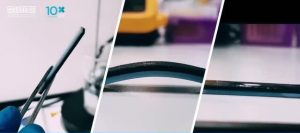
Researchers develop revolutionary reversible 4D printing process
Canadian Plastics
3D Printing Research & DevelopmentA technique developed by researchers at Singapore University of Technology and Design allows 4D-printed objects to resume their original shape.

Image Credit: SUTD
It’s a sign of the breakneck speed at which technology is advancing that 3D printing – still a cutting-edge process, with new applications, new materials, and new 3D printers still being discovered – is already giving way to the next evolution, 4D printing.
For the uninitiated, 4D printing is the process through which a 3D-printed object transforms itself into another structure in response to stimuli such as heat, water or light. It uses the same techniques of 3D printing through computer programmed deposition of material in successive layers to create a three-dimensional object but – in a nutshell – adds the dimension of transformation over time.
And believe it or not, a team at Singapore University of Technology and Design (SUTD) has gone even a step further than 4D printing by creating a new reversible 4D printing technology. In this new process, not only can a 3D-printed object change shape in response to either heat or water, it can also revert back to its original shape without human intervention. Until now, a 4D-printed object could only change back to its original shape by the manual stretching or pulling of the object – which can be laborious and time consuming – or through the use of a hydrogel material that acts as a stimulus. But hydrogel lacks mechanical strength, making it a poor choice for applications that involve load bearing.
To address these challenges, researchers from SUTD collaborated with Nanyang Technological University, which is also in Singapore, to revolutionize 4D printing by making it reversible without the need for hydrogel nor human interference.
As reported in a recent paper in the Engineering journal, this research work utilized only two materials, VeroWhitePlus and TangoBlackPlus, which were more readily available and compatible for printing in a 3D polyjet printer compared to using a hydrogel. The researchers also proved in their paper that the materials were able to retain considerable mechanical strength during and after actuation.
In the process, researchers used ethanol to cause the elastomer to swell, which creates stress on the transition material, in the same way that the hydrogel does in other similar processes. Then, when heated, the transition material changes its shape to a second shape. As the ethanol is being dried out of the elastomer, heating the transition material again will then allow it to revert to its original shape, with the elastomer pulling the transition material back due to elastic energy stored in it after drying. The elastomer plays a dual function in this process: it induces stress in the programming stage and also stores elastic energy in the material during the recovery stage. This process of reversible 4D printing has also proven to be more precise when the material reverts to its original shape compared to manually stretching or inducing stress.
Although this approach is just barely in its infancy, the SUTD researchers believe that it could be used in a wide variety of applications in the future, when more mechanisms and more materials become available for printing.
“While reversible 4D printing in itself is a great advancement, being able to use a more robust material while ensuring a more precise reversal during shape change is revolutionary as it allows us to produce complex structures that cannot easily be achieved through conventional fabrication,” said Professor Chua Chee Kai, lead researcher and head of Engineering Product Development at SUTD. “By relying on environmental conditions instead of electricity, it makes it a game changer across various industries, completely changing the way we design, create, package, and ship products.”
Source: Singapore University of Technology and Design
